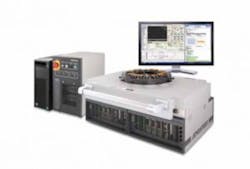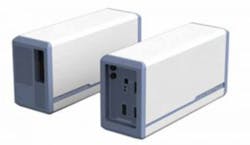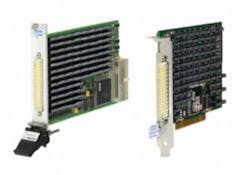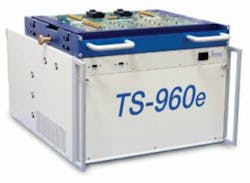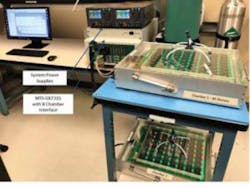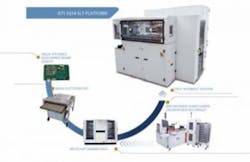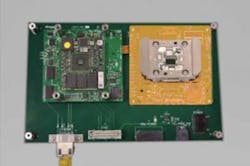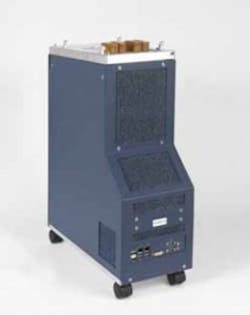Cost of test still biggest hurdle as newer factors add to challenges
Some of the biggest challenges facing providers of semiconductor test products have remained for decades: cost to test, improving the quality of the test program, and not impeding the productivity of designers will remain key obstacles to overcome. Today, additional challenges have been heaped upon the semiconductor testing arena as increasingly complex devices force test equipment providers to constantly innovate and keep up with today’s fast-paced demands. Mobile electronics are driving demand for smaller semiconductor nodes, while other modern factors like cloud utilization, artificial intelligence, and 5G all present their own difficulties for testers.
Challenges in semiconductor test
We polled a handful of leading testing semiconductor testing providers on what they see as the biggest challenges in this space, and what their company is doing to overcome them. Here’s what they had to say:
Judy Davies, vice president of marketing communication at Advantest: “The movement toward smaller semiconductor form factors continues, driven by booming demand for mobile electronics. 7-nanometer-and-smaller design nodes is now the trend in development. As a result, chips’ operating voltages continue to drop. So accuracy requirements have become critical, and parametric tests now require DC accuracy in the millivolt range. At the same time, cloud computing, big data and artificial intelligence (AI) are increasing the demand for servers and data centers, which require high-bandwidth and high-density memory devices. We foresee continuing growth in the need for massive data storage, computing-capacity enhancements and high-speed communications as the digital transformation proceeds. As a result, customers’ requirements for small, energy-efficient ICs are growing and the reliability of semiconductors is being emphasized. This is raising the bar and presenting new challenges and opportunities for the tester market. In high-performance computing, we are working with microprocessors, GPUs and special chips for AI applications, to name a few. These are complex digital chips, and specia
l challenges arise from their high power consumption during testing. Power supplies must deliver several 100 A with fast response to load changes. At the same time, these chips often have many high-speed digital interfaces so the tester must be configured with highly integrated,
high-speed cards to be able to evaluate the large number of fast signals.”
Bob Stasonis, director of sales and marketing at Pickering:
“As it has been in the past, it is most likely the cost of test. For many years, semiconductor companies had to purchase multimillion-dollar test systems that might become obsolete in only one or two years. Semiconductor manufacturers are turning to companies like Pickering for lower-cost solutions to suit their needs.”
Christopher Lemoine, product marketing director at Xcerra Tester Group: “There are many vexing test issues facing IC manufacturers today:
- 5G: Over-the-air test, mmWave, beamforming, MIMO, and dramatically increasing bandwidth all pose significant challenges. Xcerra is investing heavily and partnering with lighthouse customers to develop innovative solutions and maintain our position as a leader in wireless test solutions.
- Time to market: With continued consolidation and escalating competition in the semiconductor space, getting products to market quicker than the competition is key. With our new DxV system, Xcerra is providing a game-changing tool to allow semiconductor companies to accelerate time to market.
- Cost of test: Xcerra’s air-cooled and zero-footprint DxV and Diamondx product lines empower semiconductor companies with extreme scalability and flexibility to fine-tune their test strategies and optimize cost of test.”
Mike Dewey, director of marketing at Marvin Test Solutions:
“The single biggest challenge is the cost of test. Device costs continue to decrease, which in turn requires the cost of test to decrease, just to maintain a constant cost-of-test percentage. Additionally, suppliers are looking to lower their cost of test, which puts even more pressure on test engineering departments (and test equipment suppliers) to create lower-cost solutions. Test methods such as multi-site can help mitigate test costs but these solutions have their own costs, which can limit the overall cost reduction benefits of multisite test. We see focused, open-architecture test solutions as offering the ability to significantly decrease test costs, particularly for MEMS devices such as sensors, where the use of high-cost ATE really doesn’t fit the cost model or test needs for these types of devices.”
Anil Bhalla, senior marketing manager at Astronics:
“The biggest challenge in today’s semiconductor test landscape is that lower technology nodes, advanced packaging trends, and the complexity of the devices are driving new fault mechanisms. What we are seeing from our customers is that current test methodologies need to evolve to keep pace. System-level test is a proven method of catching many of these new failures and we see that trend now extending into new markets such as automotive, as well as expanding into current markets such as graphics, mobile, and servers.
Exhibiting at ITC
Providers in this space such as those above have had at least a handful of opportunities so far this fall to show off their latest and greatest developments in the semiconductor test arena at industry events, most recently including AUTOTESTCON Sept. 17-20 in National Harbor, MD; Strategic Materials Conference Sept. 24-26 in San Jose, CA; and EDI CON USA Oct. 17-19 in Santa Clara, CA. And at the 49th International Test Conference, held Oct. 28-Nov. 2 in Phoenix, an expected 4,000-plus engineers from around the world are expected to attend the weeklong symposium dedicated to the electronic test of devices, boards and systems—covering the complete cycle from design verification, test, diagnosis, failure analysis, and back to process and design improvement.
Advantest
As a platinum sponsor of ITC, Advantest will showcase its most advanced technology solutions for a wide range of semiconductor devices. The company’s booth will feature displays on the EVA 100 low-cost tester for analog and sensor ICs used in smart devices, as well as the TS9000 series of terahertz analysis systems, available with a high-resolution time domain reflectometry (TDR) option that pinpoints and maps the location of faults within IC packages, printed boards, and electronic components. Advantest, which has American headquarters in San Jose, CA, has combined cloud-based solutions with real-time edge computing to offer artificial intelligence that is downloadable from the cloud. The company’s subscription-based CloudTesting Service, available anytime and anywhere, also will be showcased at ITC. In addition, Advantest will exhibit its high-performance device interface for ATE. According to Davies, “The easy-to-use software on our EVA 100 tester enables the fastest time to market for customers, while the downloadable software from our benchtop CloudTesting Service helps chip designers to validate their newest circuits in record time.”
Advantest’s EVA 100 system and CloudTesting Service offer advanced test solutions that go above and beyond the capabilities of traditional ATE platforms designed for general semiconductor testing, while the company’s device interface solutions are focused on meeting the demanding signal-integrity and thermal-management challenges for the fast-growing number of high-frequency and high-power digital devices.
Pickering
U.K.-based Pickering will showcase its latest high-density PXI and USB/Ethernet LXI switching and simulation solutions at ITC, along with its signal routing software. The company’s latest High-Density Modular LXI Ethernet Reed Relay Matrix, originally designed to test semiconductors at wafer and package levels, combines Pickering’s latest LXI chassis with its new plug-in matrices. The range comprises four models that cover matrices of up to 1,536×4 in increments of 128, 768×8 in increments of 64, 384×16 in increments of 32, and 192×32 in increments of 32. It allows users to specify as many (up to six) or as few plugins required and can field upgrade the chassis to extend the matrix when necessary. Another key feature is that over 1,500 relays can be closed simultaneously for specific conditions for parametric testing.
Meanwhile, Pickering’s BRIC Ultra-High-Density Large PXI Matrix Modules are robust 1A/20W switching modules with up to 4,096 crosspoints. According to Pickering, this new generation of 1Amp PXI matrices delivers twice the density of any competing large matrix module. It’s available in two-, four-, or eight-slot PXI sizes and enable a complete functional ATE system to be housed in a single 3U PXI chassis and allow the much lower cost eight- or 14-slot PXI chassis.
Last, but not least on display for Pickering at ITC, is its Model 40-297 and 40-298 Precision Programmable Resistor Module, which was designed as a simple solution for applications requiring accurate simulation of resistive sensors. These two series includes 50 model configurations per platform, and are available in the PCI form/factor. The 40-297 uses electro-mechanical relays to offer greater thermal stability, while the 40-298 uses reed relays, which offer a relay life that is several orders of magnitude greater than the 40-297 and is recommended for applications that need support for a very long period. Each version offers users the choice of channel count, range and setting resolution.
Stanonis said Pickering addresses virtually all common types of device applications for its equipment because the company has partnered with its customers to design modules that most directly address what the customer needs. “We believe that switching in test should accommodate the DUT requirements, and not the other way around,” Stanonis said.
Marvin Test Solutions
At ITC, Irvine, CA-based Marvin Test Solutions will showcase its PXI-based TS-960e test system for digital and mixed-signal test applications as well as its PXI-based, Metal-Oxide (MOX) Gas Sensor test solution which offers a cost-effective production test solution for these MEMs-based devices.
Marvin’s portfolio of products and systems are based on the PXI architecture, which offers users a flexible and open architecture for a range of functional test applications, ranging from semiconductor device testing to complete system test. “Our software and hardware products are purpose-built and designed as part of an overall automated, functional test solution,” Dewey said of MTS. “These products are designed specifically for ATE applications with a focus on offering compact, high density, and performance test capabilities based on the open architecture of PXI. In addition, since all of our test systems are PXI-based, our customers have the flexibility to expand and modify our test systems for both current and future test needs using instrumentation from both MTS and other PXI
suppliers.”
On the software side, Marvin’s ATEasy test executive and test development software includes a comprehensive set of tools and capabilities for program development, deployment and production test. With its open architecture, virtually any Windows-based programming language can be integrated with the test executive, providing test engineers the flexibility to work with both graphical and textual-based programming environments. Additionally, MTS has expanded its semiconductor software tools portfolio with the addition of the ICEasy Test Suite. This suite includes a library of test development tools (including Shmoo and I-V plotting) for creating test programs and characterizing devices, a software tool set for importing and converting STIL, WGL, VDC/EVCD, and ATP files to a MTS digital instrument file format, and digital waveform edit/display tools.
Astronics
East Aurora, NJ-based Astronics will also exhibit at ITC, where it will emphasize system-level test and what the company calls “massively parallel test.” The company’s booth will demonstrate the building block of Astronics’ architecture—its Single-Site Device Development Board Kit, as well as its ActivATE software platform. Both offerings have helped Astronics test over 10 billion devices to-date.
“We focus on helping our customers reduce overall cost of test—something we believe is critical in order to address upcoming challenges, like lower technology nodes and advanced packaging, whether the final application is for automotive, graphics, or mobile,” Bhalla said.
ActivATE is a multi-threading framework that manages a test sequencer, a device manager, and an integrated development environment (IDE). The IDE enables the test engineer to edit and build a test program using popular production languages that include C#, VB.NET, or VBScript.
Bhalla said Astronics’ equipment can test devices for mobile devices, automotive, data centers, desktop computers, biomedical devices, wearables, IoT, and smart homes/cities. Those applicable areas include graphics, MPUs, network processors, or other mission-critical embedded systems.
“With over 20 years of experience in semiconductor test, we have over 2,000 systems deployed worldwide,” Bhalls said. “With our roots in burn-in and system-level test, we enable manufacturers of high-volume devices to consolidate the number of necessary testers, increase yield, improve ROI, and ultimately, lower overall cost of test.”
Technical presentations at ITC
At ITC, Advantest will present two papers on the morning of Nov. 1. The first is a paper on “AI Engineering Assistance for ATE,” shown by Keith Schaub and Ira Leventhal. Following that, company engineers Kiyotaka Ichiyama, Takashi Kusaka, and Masahiro Ishida will present their paper, “A Stressed Eye-Testing Module for Production Testing of 30-Gbps NRZ Signal Interfaces.”
Marvin Test will participate in ITC’s corporate forum session on Oct. 31, and the conference’s poster session on Nov. 1, and at both sessions will discuss the topic of MEMs-based, MOS gas sensor testing and the unique set of test challenges it brings. The discussion will include an overview of how a PXI-based test system can offer a very cost-effective solution compared to a solution which might employ a large ATE semiconductor test platform.
Other new semiconductor test products
Though not exhibiting at ITC, Norwood, MA-based Xcerra Tester Group has brought new products to market worth sharing. The latest of them is the company’s HSI1x instrument, for the Diamondx platform. With 32 differential transmitters and 24 differential receivers running at up to 12.8 Gbps, the HSI1x delivers what the company calls unprecedented channel density at this performance level. Designed to test high-speed SerDes ports found on the latest applications processor SoCs, display driver ICs, and related high bandwidth ICs, HSI1x supports deep pattern memory, algorithmic PRBS pattern generation, programmable jitter injection and equalization, and flexible loopback paths.
Another recent introduction from Xcerra is the AT1x, a specialized instrument for the Diamondx platform to cover the stringent testing needs of automotive interfaces. With ±100V leakage measurement and transient detect capability, 200MHz waveform measure, and 28V drivers, the AT1x provides a complete solution for high coverage and high throughput test of automotive interfaces. “One of the most unique features of the Xcerra Diamondx product line is its extreme scalability,” Lemoine said. “The DxV system is a full-blown ATE system that uses the same instruments and software as the larger Diamondx systems, but is the size of an oscilloscope.”
Lemoine said the DxV system is designed to fit on an engineer’s desk or lab bench and can be configured with up to 960 digital channels, 280 12.8Gbps SerDes ports, 360 power/analog channels, 1600 digitizers, or any combination of a wide variety of Diamondx instrumentation.
“The DxV further extends the Diamondx platform to cover lower pincount devices and lower site-count test strategies, enabled our customers to fine tune their cost-of-test equation,” Lemoine states. “Even more importantly, the DxV fundamentally redraws the roadmap of semiconductor validation to high volume production test. With the DxV, full-blown ATE can be deployed on the lab bench, allowing seamless production ramp up once silicon is validated.”
Asked what types of devices Xcerra’s semiconductor test platforms can test, Lemoine said the company’s offerings can essentially run the gamut, with areas of particular strength in:
- wireless power amplifiers, switches, front end modules, and transceivers
- wireless connectivity and IoT ICs
- automotive radar
- Microcontrollers
- applications, media, and baseband processors
- automotive power, control, and interface devices
- mobile integrated power management devices
- flat panel display drivers, and
- MEMS and sensor devices
Looking forward
Evidenced by the commentary from these leading semiconductor test providers, cost of test is top-of-mind for most, if not all of them. And the encouraging thing is that those providers are steadfastly tackling that cost challenge, whether through introducing new products like Marvin Test Solution’s MOX Gas Sensor test solution, software like Astronics’ ActiveATE platform, or education efforts such as presenting at technical sessions at future shows and informing fellow engineers how to right-size their testing procedures. EE
Semiconductor equipment billings
North American-based manufacturers of semiconductor equipment posted $2.24 billion in billings worldwide in August 2018, according to SEMI. That figure is 5.9% lower than July 2018, and 2.5% higher year-over-year compared to August 2017. That year-over-year figure has steadily and sharply decreased from a recent peak of 25.9% growth in April of this year.
For more information
About the Author


